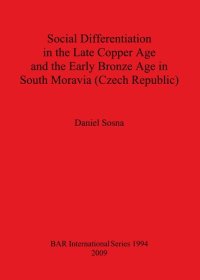
Ebook: Social Differentiation in the Late Copper Age and the Early Bronze Age in South Moravia (Czech Republic)
Author: Daniel Sosna
- Series: BAR British Archaeological Reports International Series 1994
- Year: 2009
- Publisher: BAR Publishing
- Language: English
- pdf
In this study the author tests three main hypotheses that focus on the institutionalization of vertical social differences, the different strategies that might have led to the institutionalization of vertical social differences, and changes in gender relations during the transition from the Late Copper Age to the Early Bronze Age in South Moravia (Czech Republic). In the nine chapters, the first outlines the main topics of interest and the central hypotheses, outlining the general research scope and methodology. Chapter 2 presents the main conceptual and theoretical framework, describing various aspects of social differences, their change over time, and the theoretical basis for the exploration of social differences in the mortuary archaeological record.Chapter 3 provides an introduction to the geomorphology of South Moravia and an overview of the archaeological cultures in the region, giving special attention to the Late Copper Age and the Early Bronze Age. Chapter 4 builds upon the previous two chapters and presents the three main hypotheses of this study. A series of expectations for each research hypothesis is presented along with the archaeological correlates – thus providing the necessary link between theory and characteristics that can be traced in the archaeological record. In Chapter 5 the author describes the methods used to test the research hypotheses. The first section describes the procedures for data collection. The second section discusses the methods for the analysis of intra-cemetery mortuary variability including its spatial aspects and mortuary variability between the sites and time periods. Chapter 6 discusses the archaeological sites concerned, paying special attention to four main cemeteries that are analyzed in detail. Chapters 7 and 8 present the results and discussion of the analyses. Chapter 9 concludes the main findings of the study, presenting the model of changes that occurred during the transition from the Late Copper Age to the Early Bronze Age and place the results into archaeology's wider anthropological context.